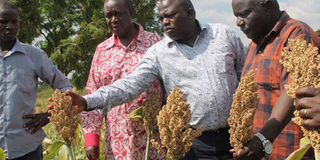Brief farming, agriculture and agribusiness news from around the country

East Africa Maltings Ltd's (EAML) general manager, Lawrence Maina examines sorghum in a farm owned by Hon Oburu Odinga in Bondo, Siaya County in this file photograph. A new variety of barley set to improve grain production and quality has been launched by EAML and University of Eldoret.
What you need to know:
- According to Presly Ouma, the research trials manager at EAML, Grace is moderately resistant to diseases and has the ability to produce many stems from one seed, increasin the yield for farmers.
- The time between planting and harvesting is six months which could vary depending on the rainfall patterns.
- National Irrigation Board agronomist Johnson Muko said the scheme will be reviving the crop with plans to scale up production.
- Representative of the farmers Mohamed Maro said farmers had agreed to the deal on condition that the cotton prices per kilo would be fixed, unlike in the past days when it kept fluctuating and finally dropped, leaving the farmers with losses.
New barley variety set to improve quality and increase yield launched, old varieties phased out over diseases
A new variety of barley set to improve grain production and quality has been launched.
The variety dubbed Grace was launched on Thursday by the East African Maltings Limited (EAML) in partnership with the University of Eldoret at the Sansora farm in Mau Narok, Nakuru County.
According to Presly Ouma, the research trials manager at EAML, Grace is moderately resistant to diseases and has the ability to produce many stems from one seed, increasin the yield for farmers.
The two previous varieties that were in the market, namely, Nguzo and Fanaka, were susceptible to diseases and have now been phased out.
“Grace also produces plump grain while its gene make up is able to resist diseases therefore minimising the amount of pestcide administered to it,” said Mr Ouma.
The time between planting and harvesting is six months which could vary depending on the rainfall patterns.
Of benefit to the brewing companies is that the new variety is also able to control the nitrogen uptake from the soil which is one of the aspects that malting processors look for when buying barley grain.
Javan Were, a plant pathologist lecturer at the University of Eldoret said a high amount of nitrogen in the grain would mean a decrease in the starch content, therefore poor for malting.
“The farmer can control the nitrogen content by doing crop rotation with plants like peas and canola that introduce small amounts of nitrogen into the soil,” he said.
In terms of yield per acre, Mr Were estimated the Grace to produce to 32 bags on the higher side and 20 bags on the lower side, depending on the land preparation by the farmer.
Lawrence Maina, the general manager at EAML said the production of barley in the country had decreased from 50,000 tonnes to 40,000 tonnes last year, when some farmers fell out of the barley growing business.
However, Mr Maina said this year; the brewers were estimating an increase of yields from 2.8 tonnes per hectare to 3.1 tonnes per hectare.
—REITZ MUREITHI
****
Hola scheme to revive cotton after agreement with farmers, ginneries
Farmers in Hola Irrigation Scheme are set to try their hands at cotton growing after the Malindi and Makueni ginneries officials visited the area to express interest in the crop.
National Irrigation Board agronomist Johnson Muko said the scheme will be reviving the crop with plans to scale up production.
“We have had discussions with the two companies and the farmers and their request has been accepted by farmers under certain conditions,” he said.
Mr Muko who is the acting scheme manager said the project would be financed by the Agricultural Finance Corporation at a cost to be announced later.
He said farmers had opposed any financial support from AFC based on their past experiences with the corporation but had given it consideration under new agreements.
“The farmers were opposed to having AFC finance the cotton growing since they did not have good experiences with the corporation in the past, but the deal this time is good and transparent,” he said.
Representative of the farmers Mohamed Maro said farmers had agreed to the deal on condition that the cotton prices per kilo would be fixed, unlike in the past days when it kept fluctuating and finally dropped, leaving the farmers with losses.
Mr Maro said they have agreed to start land preparation as early as February so as to plant the cotton before the onset of the rains in June or July.
“This is the time to start preparing land for cotton production as the rainy season may not give room for that,” he said.
The companies shall buy a kilogramme of cotton from the farmers at Sh52, with the investor targeting 5,000 to 6,000 acres of land for the crop.
The return of cotton planting is set to see the revival of the cotton ginnery in Tana River that has stalled for over a decade now and could turn around the fortunes of the people of Tana River.
“We look forward to seeing the rebirth of our textile industry in the county that died over a decade ago,” said Mr Maro.
— STEPHEN ODUOR





